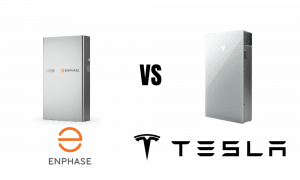In this page
When it comes to batteries, the term “lithium-ion” has become almost synonymous with the power sources that fuel our daily lives, from smartphones to electric vehicles.
However, in the world of energy storage, not all lithium-ion batteries are created equal, and they certainly don’t carry the same risks.
It’s a common misconception that all lithium-ion batteries pose the same safety concerns, but the reality is far more nuanced. In this post, we will explore lithium-ion battery risk, uncovering the variations in chemistry, design and usage that make some safer.
Energy Matters provides valuable resources. You can gain insights into the potential benefits by obtaining FREE solar quotes from Energy Matters, allowing you to make decisions without any commitment as you navigate the nuances of sustainable energy choices.
Understanding lithium-ion battery risks
Lithium-ion batteries can pose a fire risk if they are not properly manufactured, handled, stored, or disposed of. When a lithium-ion battery fails, it can overheat, explode, or release toxic gases. These incidents can cause property damage, serious injuries, and even death.
Diverse risks and their contexts
1. Fire and thermal runaway
One of the prominent risks associated with lithium-ion batteries is the potential for thermal runaway, leading to fires and explosions. In Australia, the risk of fire is particularly amplified in hot climates. High temperatures can exacerbate battery malfunction and increase the likelihood of a catastrophic event, especially in regions prone to heatwaves.
2. Environmental impact and recycling challenges
Effective recycling and disposal of lithium-ion batteries are crucial to mitigate environmental risks. In Australia, managing the end-of-life phase of these batteries remains a challenge. Improper disposal can contaminate soil and water, harming ecosystems and public health. Developing efficient recycling infrastructure and promoting responsible disposal practices are pivotal to minimising these risks.
3. Transportation and storage concerns
Transporting lithium-ion batteries, especially in bulk quantities, necessitates stringent safety measures to prevent accidents or leaks that could result in chemical exposure or fires. Furthermore, the storage of large battery packs, such as those used in renewable energy systems or EV charging stations, requires adherence to strict safety protocols to mitigate the risks of damage or malfunction.
The causes of fires behind lithium-ion batteries
Lithium-ion batteries have become an essential part of modern life, powering laptops, smartphones, electric vehicles, and a wide range of other devices. However, these batteries also pose a fire risk, and Australia has seen an increase in lithium-ion battery fires in recent years. Several factors can contribute to these fires, including:
Battery manufacturing defects
Poorly constructed batteries or manufacturing flaws can result in short circuits or overheating, leading to fires. Low-quality control measures during production may increase the risk.
Overcharging or overheating
Charging batteries beyond their recommended capacity or exposing them to high temperatures can cause thermal runaway, where the battery overheats rapidly, potentially resulting in ignition.
Physical damage
External damage or punctures to the battery can compromise its internal structure, causing a short circuit and subsequent fire.
Improper use or handling
Incorrect usage, such as using incompatible chargers or storing batteries in high-temperature environments, can trigger thermal events leading to fires.
Lack of regulations and safety standards
Inadequate regulations or lax adherence to safety standards may contribute to the proliferation of substandard batteries, increasing the risk of fire incidents associated with lithium-ion batteries in Australia.
The reality is that lithium-ion batteries in electric vehicles are safe despite the forecasts of around 900 EV fires between 2023 and 2050, which is a small amount when you consider both the number of expected EVs on the road and the comparable figure for internal combustion engine (ICE) vehicle fires.
Overall, the causes of lithium-ion batteries catching fire can be traced to several causes, such as user behaviour.
The two common chemistry variations of lithium-ion batteries are NMC and LFP. NMC (lithium nickel manganese cobalt oxide) led the market until 2020. Things shifted following numerous reports of battery fires, specifically in the early models of EVs. The change was also brought by Tesla and other EV manufacturers’ shift to LFP in 2022.
NMC isn’t all that bad; in fact, it’s lighter than LFP in weight per kWh. However, it doesn’t have a good track record when it comes to safety, longevity, and costs.
The dangers of lithium-ion are almost due to NMC, mainly due to its extremely low thermal runaway. It is not the ideal to use now as Australia’s grid suffers from insufficient infrastructure and increased demand.
On the other hand, LFP (lithium iron phosphate) has a higher thermal runaway temperature. It’s also known that iron doesn’t burn like manganese; hence, fires are a rare occurrence for those using LFPs.
Safety considerations
Lithium-ion batteries are widely used in Australia, powering a range of devices from smartphones and laptops to electric vehicles and home energy storage systems. While they offer many advantages, including high energy density and long lifespans, lithium-ion batteries pose potential risks, such as fire, explosion, and toxic chemical leaks. To mitigate these risks, handling and storing lithium-ion batteries safely is crucial, including:
1. Overcharging risks

Overcharging a lithium-ion battery happens when it is charged beyond its specific voltage limits. This happens when a charger or charging circuit malfunctions or if the user leaves a device plugged in for extended periods.
The risks of overcharging:
- Reduced battery life: Overcharging can cause a significant amount of heat to build up within the battery, leading to the degradation of the battery’s capacity over time. In extreme cases, this may lead to a malfunctioning battery as it can no longer hold a charge.
- Risk of thermal runaway: In rare cases, overcharging can cause the battery to overheat to the point where it enters thermal runaway. This can lead to fires or explosions.
- Potential for electrical damage: Overcharging can also damage the internal components of the battery, resulting in short circuits and further safety concerns.
2. Undercharging risks
Undercharging occurs when a lithium-ion battery is not charged to its minimum required voltage level. This happens when users disconnect their devices or EVs prematurely, thinking that the battery still has enough capacity left.
The risks of undercharging are:
- Reduced battery capacity: Undercharging frequently can lead to the phenomenon known as the “battery memory effect” where the battery starts to “remember” the reduced capacity. Over time, this can lead to a loss of usable capacity and shorter overall battery life.
- Inefficient use of energy: When you undercharge your EVs or other devices, it limits the use of the available energy in the battery. This can be problematic in applications where maximising energy use is critical.
- Increased charging cycles: When you undercharge, the more you need to recharge. This can increase the overall wear and tear on the battery, which will shorten its lifespan.
You can avoid undercharging by allowing lithium-ion batteries to charge fully as much as possible. It’s also important to follow the manufacturer’s recommendations for optimal charging and discharging practices.
3. Mechanical damage and puncture risks
Lithium-ion batteries are sensitive to physical damage, such as punctures or crushing. When their internal components are damaged, it can result in short circuits and, in extreme cases, thermal runaway. This is particularly common in EVS.
To reduce the risk of mechanical damage, batteries are often encased in robust, impact-resistant materials. However, users must still handle devices with care and avoid subjecting them to extreme physical stress.
4. Temperature and operating conditions
Lithium-ion batteries perform well within a certain temperature range. Operating them outside this range can lead to reduced efficiency and potentially dangerous consequences. Extremely low temperatures can hinder the battery’s chemical reactions, while high temperatures can accelerate degradation and increase the risk of thermal runaway.
Proper temperature management is necessary, especially in environments where batteries are exposed to extreme conditions.
Damage batteries are often encased in robust, impact-resistant materials. However, users must still handle devices with care and avoid subjecting them to extreme physical stress.
Safe disposal of lithium-ion batteries
Safe and proper disposal of lithium-ion batteries is necessary because they are considered hazardous due to the toxic chemicals, heavy metals and other pollutants they contain that could contaminate water supplies and ecosystems.
Wear hand protection before touching or moving leaking lithium batteries; otherwise, they could cause severe burns.
Never dispose of lithium-ion batteries in your rubbish or recycling bin. Instead, take advantage of B-cycle, the country’s national battery recycling scheme and find the nearest disposal in your area.
How to put out a lithium-ion fire
There are various methods to extinguish fire brought by lithium batteries. Never attempt to put out the fires by yourself. If you notice hissing or crackling sounds from a battery or a device, leaking, case discolouration, bulging or swelling, leave your property and call 000 fire brigade.
Not a one-size-fits-all scenario
It is important to note that the risks associated with lithium-ion batteries vary depending on the specific battery type and application. For example, the risks associated with a lithium-ion battery in a smartphone are generally lower than those associated with a large lithium-ion battery in an electric vehicle.
Consumers should always follow the manufacturer’s instructions for handling, storing, and disposing of lithium-ion batteries. They should also be aware of the signs of a failing battery, such as swelling, overheating, or unusual odour.
So, are lithium batteries a huge fire risk?
Whilst lithium batteries do carry a risk of fire, recognise that these risks can be managed and mitigated effectively. The perceived risk should not deter the use of this type of battery as they are critical in powering today’s modern world.
As technology advances and safety measures continue to improve, the fire risk associated with lithium batteries is becoming increasingly manageable. Nonetheless, staying informed and adhering to safety guidelines remains a vital aspect of ensuring the safe use of these power sources.
FAQs | Frequently Asked Questions
Are lithium-ion batteries dangerous?
Lithium-ion batteries are a type of rechargeable battery that is commonly used in electronic devices such as laptops, smartphones, and tablets. They are also increasingly being used in electric cars. Lithium-ion batteries are generally safe but can pose a fire hazard if damaged or improperly used.
What makes lithium ion batteries dangerous?
Lithium-ion batteries, while prevalent in powering our modern devices, possess inherent risks due to their chemical composition and design. Their volatile nature stems from highly reactive materials like lithium cobalt oxide, lithium iron phosphate, or lithium manganese oxide within the battery cells. When damaged, overcharged, or exposed to high temperatures, these batteries can undergo thermal runaway—a chain reaction leading to rapid overheating, gas generation, and potential explosion or fire.
Moreover, the electrolyte solution, usually flammable organic solvents, can ignite when released, exacerbating the hazard. These dangers emphasise the importance of properly handling, storing and recycling lithium-ion batteries to mitigate potential risks to individuals and the environment.
Is lithium batteries bad for the environment?
Lithium-ion batteries, while a significant advancement in portable energy storage, do pose environmental concerns. The extraction and processing of lithium, cobalt, and other rare earth metals used in these batteries can result in ecosystem disruption, water contamination, and soil depletion.
Additionally, improper disposal and recycling methods can lead to the release of toxic chemicals, contributing to air and water pollution. Despite their efficiency in reducing greenhouse gas emissions when used in electric vehicles and renewable energy storage, the full life cycle of lithium batteries warrants careful management and sustainable practices to mitigate their environmental impact.
Unleash the potential of solar battery storage! Are you ready to transform the way you power your business or household? Say goodbye to rising electricity costs and unpredictable energy grids. The state-of-the-art solar battery systems empower you to maximise your energy efficiency, save money, and reduce your carbon footprint – all while enjoying an uninterrupted power supply.
Let us discuss and choose the best quote that suits your needs and budget, and we can connect you with our trusted local installers, who will provide up to 3 FREE solar quotes for your business solar and home battery system.













































